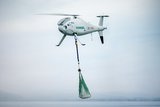iRobot receives $7.4m SUGV order
iRobot Corp., a leader in delivering robotic technology-based solutions, has received a $7.4 million order from the US military for Small Unmanned Ground Vehicles (SUGV). The company expects to complete delivery of the robots by the end of June. Additional details about the order and customer are not available.
SUGV, a tactical mobile robot, gathers situational awareness in dangerous conditions for warfighters and public safety professionals.
"SUGV robots give the operator a chance to assess potential threats before sending in personnel," said Robert Moses, president of iRobot's Government and Industrial Robots division. "A better understanding of the operating environment results in greater mission success and more lives saved."
iRobot and Boeing developed the SUGV family of unmanned ground vehicles under a strategic alliance that began in 2007.
Source: iRobot
More from Uncrewed Vehicles
-
Jammer resistant drone designs spark search for countermeasures
The Russia-Ukraine conflict has driven another stage of evolution for drones and the counter measures to defend against them.
-
![L3Harris launches Amorphous software for control of uncrewed platforms]()
L3Harris launches Amorphous software for control of uncrewed platforms
The new Amorphous software is a universal controller that would allow a single operator to control a swarm of “thousands” of uncrewed systems, from drones to underwater platforms.
-
ideaForge unveils new UAVs at Aero India 2025
India UAV supplier ideaForge has launched the Netra 5 and Switch V2 drones at Aero India 2025, boasting of enhanced endurance, AI-driven autonomy and improved operational capabilities.
-
![Shaping the future of defence: What 2025 holds for the global drone market]()
Shaping the future of defence: What 2025 holds for the global drone market
The UAV market is experiencing unprecedented growth, with innovations in technology and battlefield applications driving demand across military sectors. From the battlefields of Ukraine to NATO exercises and beyond, drones are transforming how wars are fought and supported.
-
![Maris-Tech confirms customers signing up for Jupiter Drones codec and AI-powered system]()
Maris-Tech confirms customers signing up for Jupiter Drones codec and AI-powered system
Launched at AUSA in October, the company’s multi-stream video codec is attempting to bring a new lease of life to drone technology through its AI accelerator.
-
![AUSA 2024: Quantum-Systems targets big 2025 with UAS developments]()
AUSA 2024: Quantum-Systems targets big 2025 with UAS developments
Quantum-Systems has been upgrading its UAS family, with new versions of the Vector, Reliant and Twister drones set for release throughout 2025.






















